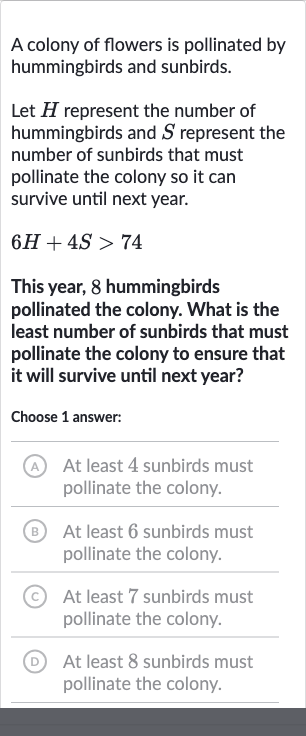AI tutor
Welcome to Bytelearn!
Let’s check out your problem:

A colony of flowers is pollinated by hummingbirds and sunbirds.Let represent the number of hummingbirds and represent the number of sunbirds that must pollinate the colony so it can survive until next year.6H+4S > 74This year, hummingbirds pollinated the colony. What is the least number of sunbirds that must pollinate the colony to ensure that it will survive until next year?Choose answer:A At least sunbirds must pollinate the colony.B At least sunbirds must pollinate the colony.(C) At least sunbirds must pollinate the colony.(D) At least sunbirds must pollinate the colony.
Full solution
Q. A colony of flowers is pollinated by hummingbirds and sunbirds.Let represent the number of hummingbirds and represent the number of sunbirds that must pollinate the colony so it can survive until next year.This year, hummingbirds pollinated the colony. What is the least number of sunbirds that must pollinate the colony to ensure that it will survive until next year?Choose answer:A At least sunbirds must pollinate the colony.B At least sunbirds must pollinate the colony.(C) At least sunbirds must pollinate the colony.(D) At least sunbirds must pollinate the colony.
- Substitute Hummingbirds: Substitute the number of hummingbirds into the inequality.6H + 4S > 746(8) + 4S > 74
- Multiply Contribution: Perform the multiplication to find the contribution of the hummingbirds to the inequality.48 + 4S > 74
- Isolate Sunbirds Term: Subtract the hummingbird contribution from both sides of the inequality to isolate the term with .48 + 4S - 48 > 74 - 484S > 26
- Divide to Solve: Divide both sides of the inequality by to solve for .\frac{4S}{4} > \frac{26}{4}S > 6.5
- Round Up: Since represents the number of sunbirds and it must be a whole number, we round up because must be greater than .
More problems from One-step inequalities: word problems
QuestionGet tutor help
QuestionGet tutor help
QuestionGet tutor help
QuestionGet tutor help
QuestionGet tutor help
QuestionGet tutor help
QuestionGet tutor help
QuestionGet tutor help
QuestionGet tutor help
QuestionGet tutor help
